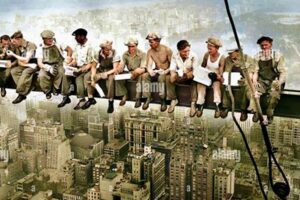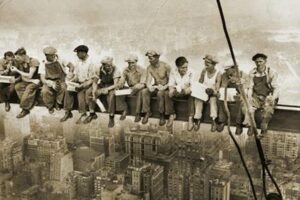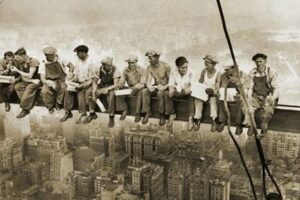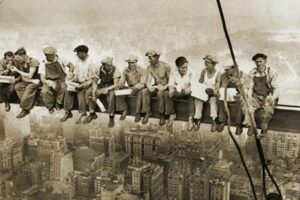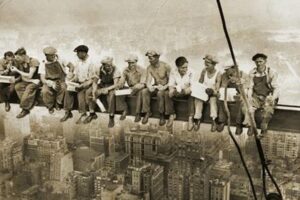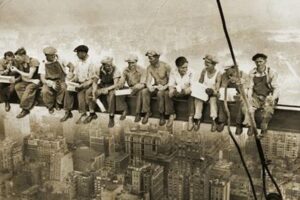The “Lunch atop a Skyscraper” photograph is a black-and-white image taken on September 20, 1932, during the construction of the RCA Building in New York City. The photograph shows eleven construction workers eating lunch, seated on a steel beam 840 feet (256 m) above the ground. The photograph has become one of the most iconic images of the 20th century and has been widely reproduced and referenced in popular culture.
The photograph was taken by Charles C. Ebbets, a photographer for the Bethlehem Steel Corporation. Ebbets was assigned to photograph the construction of the RCA Building, and he had been taking pictures of the workers for several weeks. On the day the photograph was taken, Ebbets was having lunch with the workers when he noticed them sitting on the beam. He asked them to pose for a photograph, and they agreed. The photograph was published in the Bethlehem Steel magazine, and it quickly became a sensation.
The “Lunch atop a Skyscraper” photograph has been praised for its realism and its dramatic composition. The photograph captures the danger and excitement of working on a skyscraper, and it has become a symbol of the American spirit. The photograph has also been used to illustrate the importance of safety in the workplace, and it has been used in advertising campaigns for a variety of products and services.
1. Composition
The composition of “Lunch atop a Skyscraper” has been a subject of scrutiny due to its seemingly deliberate arrangement. Unlike candid photographs that capture spontaneous moments, this image exhibits a calculated placement of the workers, with each individual positioned for maximum visual impact. This suggests that the photograph was carefully staged rather than a random capture of an everyday occurrence on the construction site.
- Symmetry: The photograph’s symmetry, with the workers evenly spaced along the beam, creates a sense of balance and order. This symmetry is not typically found in candid photographs, which tend to be more asymmetrical and dynamic.
- Lighting: The lighting in the photograph is even and diffused, creating a studio-like effect. This is in contrast to the harsh and uneven lighting conditions that would be present on a construction site, especially at such a great height.
- Clothing: The workers in the photograph are all wearing clean and pressed clothing, which is unusual for construction workers who would typically have dirty and worn clothing. This suggests that the workers were made to change their clothes for the photograph.
- Safety: The absence of safety harnesses or other protective gear in the photograph raises concerns about the workers’ safety. This suggests that the photograph was staged, as it is unlikely that construction workers would risk their lives by not wearing proper safety gear.
The careful composition of “Lunch atop a Skyscraper” raises questions about its authenticity. The image’s symmetry, lighting, clothing, and lack of safety precautions all suggest that the photograph was staged, rather than a candid capture of a real-life event.
2. Lighting
The lighting in “Lunch atop a Skyscraper” has been a subject of scrutiny due to its artificial appearance. Unlike candid photographs that capture the natural lighting conditions of a scene, this image exhibits an even and diffused light, creating a studio-like effect. This is in contrast to the harsh and uneven lighting conditions that would be present on a construction site, especially at such a great height.
The lack of shadows in the photograph further suggests that it was taken in a controlled environment. Natural light typically creates shadows, especially when objects are exposed to direct sunlight. However, in “Lunch atop a Skyscraper,” the workers and the beam they are sitting on are evenly lit, with no visible shadows. This suggests that the photograph was taken in a studio or another controlled environment where the lighting could be manipulated.
The artificial lighting in “Lunch atop a Skyscraper” raises questions about the authenticity of the photograph. The even lighting and lack of shadows suggest that the photograph was staged, rather than a candid capture of a real-life event.
3. Clothing
The clothing worn by the workers in “Lunch atop a Skyscraper” has been a subject of scrutiny due to its inconsistency with the dirty and dangerous nature of their work. Construction workers typically wear dirty and worn clothing due to the nature of their work, which involves handling heavy materials, working with tools, and being exposed to harsh weather conditions. However, in the photograph, the workers are all wearing clean and pressed clothing, which suggests that they may have changed their clothes for the photograph.
The discrepancy between the workers’ clothing and the nature of their work raises questions about the authenticity of the photograph. If the photograph is genuine, it is possible that the workers changed their clothes for the photograph to present a more professional image. However, this raises concerns about the accuracy of the photograph, as it may not accurately represent the everyday working conditions of construction workers.
The clothing worn by the workers in “Lunch atop a Skyscraper” is an important detail to consider when examining the photograph’s authenticity. The clean and pressed clothing is inconsistent with the dirty and dangerous nature of their work, which suggests that the photograph may have been staged.
4. Safety
The absence of safety harnesses or other protective gear in “Lunch atop a Skyscraper” has raised concerns about the workers’ well-being and the authenticity of the photograph. Construction workers typically wear safety harnesses and other protective gear to protect themselves from falls and other hazards. However, in the photograph, the workers are not wearing any safety gear, which suggests that the photograph may have been staged or that the workers were not following proper safety procedures.
- Lack of Safety Gear: Construction workers typically wear safety harnesses and other protective gear to protect themselves from falls and other hazards. However, in “Lunch atop a Skyscraper,” the workers are not wearing any safety gear, which is a violation of safety protocols and raises concerns about their well-being.
- Staged Photograph: The absence of safety gear in the photograph suggests that it may have been staged, as construction workers would not typically risk their lives by not wearing proper safety gear. This raises questions about the authenticity of the photograph and whether it accurately represents the working conditions of construction workers.
- OSHA Regulations: The Occupational Safety and Health Administration (OSHA) has regulations that require construction workers to wear safety harnesses and other protective gear when working at heights. The absence of safety gear in “Lunch atop a Skyscraper” suggests that the workers were not following proper safety procedures, which could have put their lives at risk.
- Historical Context: The photograph was taken in 1932, during the Great Depression. At the time, safety regulations were not as strict as they are today, and construction workers often worked in dangerous conditions without proper safety gear. However, the absence of safety gear in “Lunch atop a Skyscraper” is still concerning, as it shows that the workers were taking unnecessary risks.
The absence of safety harnesses or other protective gear in “Lunch atop a Skyscraper” raises concerns about the workers’ well-being and the authenticity of the photograph. While it is possible that the photograph was staged or that the workers were not following proper safety procedures, it is also possible that the photograph accurately reflects the dangerous working conditions that construction workers faced during the Great Depression.
5. Context
The photograph “Lunch atop a Skyscraper” has been scrutinized for its lack of typical construction equipment and materials, raising questions about its authenticity. While construction sites are typically cluttered with tools, materials, and equipment, the photograph shows the workers sitting on a bare steel beam with no visible tools or materials nearby.
- Staged Photograph: The absence of construction equipment and materials suggests that the photograph may have been staged, as it is unlikely that construction workers would be sitting on a beam without any tools or materials nearby. This raises questions about the authenticity of the photograph and whether it accurately represents the working conditions of construction workers.
- Selective Editing: It is also possible that the photograph has been selectively edited to remove any visible construction equipment or materials. This could have been done to create a more dramatic or iconic image, but it also raises concerns about the photograph’s authenticity and whether it accurately represents the scene that was captured.
- Historical Context: The photograph was taken in 1932, during the Great Depression. At the time, construction projects were often delayed or cancelled due to lack of funding. It is possible that the construction site in the photograph was not fully operational, which could explain the lack of construction equipment and materials.
- Symbolic Representation: The photograph may also be interpreted as a symbolic representation of the construction workers’ lunch break, rather than a literal depiction of their working environment. The lack of construction equipment and materials could be seen as a way to emphasize the workers’ humanity and their need for rest and relaxation, even in the midst of a dangerous and demanding job.
The lack of typical construction equipment and materials in “Lunch atop a Skyscraper” raises questions about its authenticity and its historical accuracy. However, it is also possible that the photograph is a staged or symbolic representation, rather than a literal depiction of the construction workers’ working environment.
6. Identity
The identities of the workers in the iconic photograph “Lunch atop a Skyscraper” have been a subject of debate and speculation, further adding to the mystery surrounding its authenticity. While some of the workers have been identified, others remain unknown, fueling questions about the photograph’s origins and the true identities of the individuals depicted.
- Unidentified Workers: Several of the workers in the photograph have never been identified, despite extensive research and efforts to locate them or their families. This anonymity has contributed to the ongoing debate about the authenticity of the photograph, as it raises questions about why their identities would be unknown if the photograph were genuine.
- Conflicting Accounts: There have been conflicting accounts and testimonies regarding the identities of the workers in the photograph. Some individuals have claimed to be the workers depicted, while others have disputed these claims, leading to confusion and uncertainty about the true identities of the individuals in the image.
- Historical Context: The photograph was taken during the Great Depression, a time of economic hardship and high unemployment. It is possible that some of the workers in the photograph were undocumented immigrants or transient workers who did not have a permanent address or stable employment, which could explain why their identities remain unknown.
- Symbolic Representation: The photograph has also been interpreted as a symbolic representation of the construction workers’ experience during the Great Depression. In this interpretation, the anonymity of the workers is seen as a reflection of the larger social and economic forces that shaped their lives and the challenges they faced.
The disputed identities of the workers in “Lunch atop a Skyscraper” have added to the photograph’s mystique and have played a role in the ongoing debate about its authenticity. While the true identities of some of the workers may never be known, the photograph remains a powerful and iconic image that captures the spirit and resilience of construction workers during a challenging time in history.
7. Purpose
The photograph “Lunch atop a Skyscraper” was commissioned by Bethlehem Steel, a steel company that was involved in the construction of the RCA Building. The photograph was intended to be used as promotional material for the company, and this raises questions about its journalistic integrity. A journalistic photograph is typically intended to be an objective and unbiased representation of a newsworthy event or issue. However, a promotional photograph is intended to promote a particular product or service, and this may lead to bias in the image.
In the case of “Lunch atop a Skyscraper,” the photograph was carefully staged to create a dramatic and iconic image that would promote Bethlehem Steel and the RCA Building. The workers in the photograph are all wearing clean and pressed clothing, and they are all sitting on the beam in a relaxed and carefree manner. This image presents an idealized and unrealistic view of construction work, and it does not accurately represent the dangerous and difficult conditions that construction workers typically face.
The use of “Lunch atop a Skyscraper” as promotional material for Bethlehem Steel raises important questions about the ethics of photojournalism. While it is common for companies to use photographs to promote their products or services, it is important for these photographs to be truthful and accurate. “Lunch atop a Skyscraper” is a powerful and iconic image, but it is important to remember that it was created for promotional purposes and that it does not accurately represent the reality of construction work.
FAQs
The iconic photograph “Lunch atop a Skyscraper” has sparked numerous inquiries and debates regarding its authenticity. Here are some frequently asked questions (FAQs) and their corresponding answers:
Question 1: Is the photograph staged or genuine?
While the photograph has been widely accepted as genuine, there are aspects that have fueled ongoing debates about its authenticity. The carefully arranged composition, even lighting, clean clothing of the workers, and absence of safety gear have raised questions about whether the image was staged. However, it remains a powerful and iconic representation of construction workers’ spirit and resilience during a challenging time in history.
Question 2: Why are the workers not wearing safety harnesses?
The absence of safety harnesses in the photograph has raised concerns about the workers’ safety. It is possible that the photograph was staged, or that the workers were not following proper safety procedures. However, it is also important to consider the historical context, as safety regulations were not as strict during the time the photograph was taken.
Question 3: Who are the workers in the photograph?
The identities of the workers in the photograph have been a subject of debate and speculation. While some have been identified, others remain unknown, adding to the photograph’s mystique. Conflicting accounts and testimonies have further contributed to the uncertainty surrounding their identities.
Question 4: What is the purpose of the photograph?
The photograph was commissioned by Bethlehem Steel, the steel company involved in constructing the RCA Building. It was intended for promotional use, which raises questions about its journalistic integrity. While promotional photographs may be biased, “Lunch atop a Skyscraper” remains a powerful image capturing the spirit of construction workers.
Question 5: Is the photograph a true representation of construction work?
The photograph presents an idealized and unrealistic view of construction work. It depicts the workers in a relaxed and carefree manner, without accurately representing the dangerous and difficult conditions they typically face. It is important to remember that the photograph was created for promotional purposes and does not reflect the reality of construction work.
Question 6: What is the significance of the photograph?
“Lunch atop a Skyscraper” has become an iconic image, symbolizing the courage, determination, and resilience of construction workers. It has been widely reproduced and referenced in popular culture, serving as a reminder of the contributions and sacrifices made by these individuals.
In conclusion, while questions and debates surround the authenticity and details of “Lunch atop a Skyscraper,” it remains a powerful and iconic image that captures a moment in time and celebrates the human spirit. The photograph’s significance lies in its ability to inspire and remind us of the challenges faced and overcome by construction workers throughout history.
Transition to the next article section:
Explore the historical context and cultural impact of “Lunch atop a Skyscraper” in the following section.
Tips for Analyzing “Is the Lunch Atop a Skyscraper Real?”
To effectively analyze the photograph “Lunch atop a Skyscraper” and the surrounding debates about its authenticity, consider the following tips:
Tip 1: Examine the Composition and Lighting
Analyze the photograph’s composition, including the arrangement of the workers, the symmetry, and the lighting. Consider whether these elements suggest a staged or candid capture.
Tip 2: Evaluate the Workers’ Clothing and Safety Gear
Pay attention to the workers’ clothing and the absence of safety gear. Consider whether these details align with the typical conditions of construction work.
Tip 3: Research the Historical Context
Investigate the historical context of the photograph, including safety regulations and the economic climate during the Great Depression. This information can provide insights into the working conditions and practices of the time.
Tip 4: Consider the Photograph’s Purpose
Remember that the photograph was commissioned by Bethlehem Steel for promotional purposes. Be mindful of how this may have influenced the image’s content and presentation.
Tip 5: Examine the Identities of the Workers
Explore the efforts to identify the workers in the photograph. Consider the challenges and implications of their anonymity or disputed identities.
Key Takeaways:
- A thorough analysis involves examining multiple aspects of the photograph.
- Consideration of historical context and the photograph’s purpose is crucial.
- The photograph remains an iconic representation of construction workers’ spirit, regardless of debates about its authenticity.
Transition to Conclusion:
In conclusion, analyzing “Lunch atop a Skyscraper” requires a comprehensive approach that considers the photograph’s composition, the workers’ appearance, the historical context, its intended purpose, and the identities of the individuals depicted. By applying these tips, you can gain a deeper understanding of the photograph’s significance and the ongoing debates surrounding its authenticity.
Conclusion
The exploration of “Is the Lunch Atop a Skyscraper Real?” has revealed a complex and multifaceted narrative. While questions about its authenticity persist, the photograph remains an iconic representation of the spirit and resilience of construction workers during a challenging time in history.
The photograph’s carefully crafted composition, the absence of safety gear, and the workers’ idealized appearance have fueled debates about its authenticity. However, the historical context, including the Great Depression and the photograph’s promotional purpose, provide important insights into its creation.
The ongoing debates surrounding the photograph’s authenticity serve as a reminder of the importance of critical analysis and the examination of multiple perspectives. “Lunch atop a Skyscraper” continues to captivate and provoke thought, inspiring us to consider the complexities of history, representation, and the human experience.


